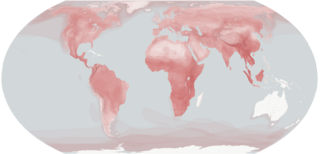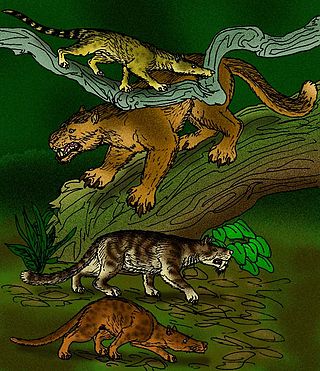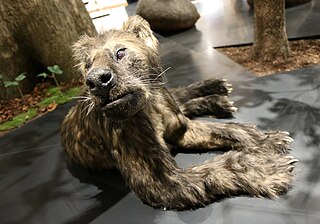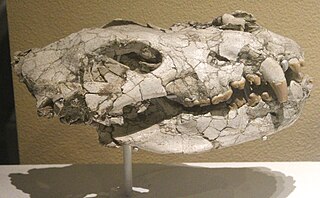
Carnivora is an order of placental mammals that have specialized in primarily eating flesh, whose members are formally referred to as carnivorans. The order Carnivora is the sixth largest order of mammals, comprising at least 279 species on every major landmass and in a variety of habitats, ranging from the cold polar regions of Earth to the hyper-arid region of the Sahara Desert and the open seas. These mammals have a large array of diverse body plans with a wide diversity of shapes and sizes.

Amphicyonidae is an extinct family of terrestrial carnivorans belonging to the suborder Caniformia. They first appeared in North America in the middle Eocene, spread to Europe by the late Eocene, and further spread to Asia and Africa by the early Miocene. They had largely disappeared worldwide by the late Miocene, with the latest recorded species at the end of the Miocene in Africa. They were among the first carnivorans to evolve large body size. Amphicyonids are colloquially referred to as "bear-dogs".

Caniformia is a suborder within the order Carnivora consisting of "dog-like" carnivorans. They include dogs, bears, raccoons, and mustelids. The Pinnipedia are also assigned to this group. The center of diversification for the Caniformia is North America and northern Eurasia. Caniformia stands in contrast to the other suborder of Carnivora, the Feliformia, the center of diversification of which was in Africa and southern Asia.

Creodonta is a former order of extinct carnivorous placental mammals that lived from the early Paleocene to the late Miocene epochs in North America, Europe, Asia and Africa. Originally thought to be a single group of animals ancestral to the modern Carnivora, this order is now usually considered a polyphyletic assemblage of two different groups, the oxyaenids and the hyaenodontids, not a natural group. Oxyaenids are first known from the Palaeocene of North America, while hyaenodonts hail from the Palaeocene of Africa.

Miacis is an extinct genus of placental mammals from clade Carnivoraformes, that lived in North America from the early to middle Eocene.

Amphicyon is an extinct genus of large carnivorans belonging to the family Amphicyonidae, subfamily Amphicyoninae, from the Miocene epoch. Members of this family received their vernacular name for possessing bear-like and dog-like features. They ranged over North America, Europe, Asia, and Africa.

The John Day Formation is a series of rock strata exposed in the Picture Gorge district of the John Day River basin and elsewhere in north-central Oregon in the United States. The Picture Gorge exposure lies east of the Blue Mountain uplift, which cuts southwest–northeast through the Horse Heaven mining district northeast of Madras. Aside from the Picture Gorge district, which defines the type, the formation is visible on the surface in two other areas: another exposure is in the Warm Springs district west of the uplift, between it and the Cascade Range, and the third is along the south side of the Ochoco Mountains. All three exposures, consisting mainly of tuffaceous sediments and pyroclastic rock rich in silica, lie unconformably between the older rocks of the Clarno Formation below and Columbia River basalts above.

Ursoidea is a superfamily of arctoid carnivoran mammals that includes the families Subparictidae, Amphicynodontidae, and Ursidae. The last family includes the extant lineages of bears, as well as the extinct Hemicyoninae and Ursavinae.

Agnotherium is a genus of large sized carnivoran mammals, belonging to the Amphicyonidae, which has been found in Western Europe, and possibly China and Northern Africa, and lived during the Late Miocene epoch. Despite only being known from fragmentary remains, the genus notable for hypercarnivorous adaptions, which have been said to represent the "apex" among its family.

Pseudocyon is a genus of amphicyonid which inhabited Eurasia and North America during the Miocene epoch living approximately 3.22 million years.

Gobicyon is an extinct genus of large-sized carnivoran mammals, belonging to the Amphicyonidae, that was discovered in China, Mongolia, and Serbia, and lived during the Middle Miocene epoch. Despite only being known from rather fragmentary remains, recent discoveries showcase that it was an aberrant member of the subfamily Haplocyoninae, with adaptions towards bone-crushing similar to those of a hyaena.

Ysengrinia is an extinct genus of carnivoran in the family Amphicyonidae (beardogs), which lived in Europe, Asia, and North America during the Early Miocene. It was also reported from Egypt and Namibia, but this material has been reassigned to other genera of beardogs.

Arctoidea is a clade of mostly carnivorous mammals which include the extinct Hemicyonidae (dog-bears), and the extant Musteloidea, Pinnipedia, and Ursidae (bears), found in all continents from the Eocene, 46 million years ago, to the present. The oldest group of the clade is the bears, as their CMAH gene is still intact. The gene became non-functional in the common ancestor of the Mustelida. Arctoids are caniforms, along with dogs (canids) and extinct bear dogs (Amphicyonidae). The earliest caniforms were superficially similar to martens, which are tree-dwelling mustelids. Together with feliforms, caniforms compose the order Carnivora; sometimes Arctoidea can be considered a separate suborder from Caniformia and a sister taxon to Feliformia.

Amphicyoninae is a subfamily of extinct amphicyonids, large terrestrial carnivores sometimes called "bear-dogs", belonging to the suborder Caniformia, which inhabited North America, Eurasia, and Africa from the middle Eocene to the late Miocene.

Palaeogale is an extinct genus of carnivorous mammal known from the Late Eocene, Oligocene, and Early Miocene of North America, Europe, and Eastern Asia. A small carnivore often associated with the mustelids, Palaeogale might have been similar to living genets, civets, and linsangs.

Gustafsonia is an extinct genus of carnivoran belonging to the family Amphicyonidae. The type species, Gustafsonia cognita, was described in 1986 by Eric Paul Gustafson, who originally interpreted it as a miacid and named it Miacis cognitus. It was subsequently considered to be the only species of the diverse genus Miacis that belonged to the crown-group Carnivora, within the Caniformia, and it was ultimately assigned to the family Amphicyonidae. The type specimen or holotype was discovered in Reeve's bonebed, western Texas, in the Chambers Tuff Formation in 1986. The University of Texas holds this specimen. It is the only confirmed fossil of this species.

Magericyon is an extinct genus of Amphicyonid ("bear-dog") that lived during the Miocene 10-9 Ma in what is now Spain.
Ammitocyon is a genus of large sized carnivoran mammals, belonging to the Amphicyonidae, that lived during the Late Miocene in what is now Spain. It is notable for its extreme adaptations towards hypercarnivory, its extremely robust skeleton, and was one of the last surviving members of its family.
Bonisicyon is an extinct genus of carnivoran mammals, belonging to the family Amphicyonidae. It is the last-surviving member of its family, living in East Africa during the end of the Miocene epoch. Known only from a damaged mandible and isolated teeth from the Nawata Formation, and possibly also the Lukeino Formation, its closer taxonomic affinities are unclear. It is notable for both its small size, and its unique dentition.
Delotrochanter is an extinct genus of large-sized carnivoran mammals, belonging to the Amphicyonidae, that lived in the Great Plains of North America during the Oligocene to Early Miocene. This genus includes some of the largest and last surviving members of the subfamily Temnocyoninae. it furthermore possesses adaptions towards both bone-crushing and cursoriality.



















